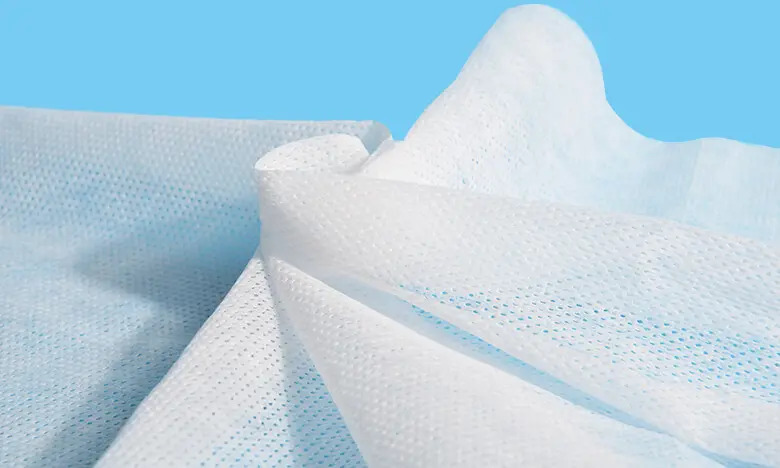Directional or random fibers make up nonwoven cloth. It's a brand-new age in sustainable building materials. When wet, it's impenetrable but also breathable and flexible. It's non-combustible but also simple to breakdown.
Recycling and low-cost. PP pellets, for example, are utilized as raw materials and manufactured using the continuous one-step technique of high temperature melting, spinning, laying, hot pressing and coiling of polypropylene pellets.
It is referred to as fabric because of its look and some of its characteristics.
41% of the world's total output is produced in the United States, with Europe and Japan each contributing 30%, China only accounting for 3.5 percent, while the world's total consumption is 17.5 percent of that in China. By 2007, China's production is expected to reach 7% of the world's output, while its consumption is expected to rise to 21% of the world's.
Nonwovens are still dominated by man-made fibers, and this will not change much until 2007. There are 63 percent polypropylene, 23 percent polyester, 8 percent viscose, 2 percent acrylic, 1.5 percent polyamide and the remaining 3 percent are different fibers used in the manufacturing of nonwovens globally
Increasingly, non-woven fabrics are being used in sanitary absorbent materials, medicinal, transportation, and shoe-making textiles.

Creating and Using Nonwovens
In 1983, the worldwide consumption of non-woven textiles was 800,000 tons; in 1985, 110 tons; in 1988, 1.4 million tons; and in 1998, 2.4 million tons. Annual usage is expected to reach 3.7 million tons by 2005, according to current estimates.
In 1983, 16.9 million metric tons of man-made fibers were used. By 1988, that number had risen to 20.4 million metric tons, and by 1998, it had risen to 30.4 million metric tons. Its use is expected to reach 37 million tons by 2005, according to current estimates. Approximately 38.3 million tons are produced in the United States per year.
Man-made fiber consumption in non-woven manufacture is predicted to expand by 10% in 2005 and by 10.4% in 2007. China, Southeast Asia, Latin America, and the Middle East have all seen a surge in auxiliary industries, which has resulted in an increase in nonwovens usage.
Factors determining nonwoven fabric growth rates
When it comes to textiles made of man-made fibers, non-woven textiles have a greater influence than any other textiles made of man-made fiber. Non-woven fabrics are less affected by population expansion than other textiles used in clothing. However, when it comes to nonwovens in infant diapers, the rise in the global population is a significant consideration.
Textiles are more affected by the replacement of natural fibers, however non-woven fabrics are less affected since the manufacturing of non-woven fabrics is mostly dependent on synthetic fibers.
Commercial development of man-made fibers and professional use of non-woven fabrics: Trade in microfibers, composite fibers, biodegradable fibers, and novel polyester fibers has increased since the introduction of international economic treaties. Clothing and knitted textiles are less affected by this than non-woven materials. Textiles and other goods may be substituted:. In addition to non-woven and knitted fabrics, polyurea foam, wood pulp and leather may also be substituted. This is based on the product's pricing and performance criteria.
For example, the use of new competitive non-woven fabrics, the development of unique fiber and additive for non-woven textiles, and the introduction of new, more efficient manufacturing techniques.
Three of the most common fibers used in non-woven manufacture are polypropylene (62 percent), polyester (24) and viscose (26%). (8 percent of the total). Viscose fiber was the most commonly used non-woven fabric material between 1970 and 1985. Polypropylene and polyester fibers have taken over in the sanitary absorbents and medical textiles fields in the last five years. To produce synthetic leather, nylon was employed in the early stages, but since 1998 the usage of acrylic fibers has increased significantly.
Features
Direct polymer chips or short fibers are used to produce the fibers by air flow or equipment before hydroentanglement, needle punching or hot rolling reinforcement is used to complete the fabric, which is a non-woven fabric. Non-woven cloth that has been weaved. Lint is not produced by this new form of fiber product; it's long-lasting and silky-soft; it's breathable; and it has the look and feel of cotton. Non-woven bags are less expensive and easier to make than cotton ones.
Polypropylene is the primary raw material for most non-woven textiles, whereas polyethylene is the primary raw material for plastic bags.
In spite of their names, these two compounds have quite distinct chemical structures. It takes 300 years for a plastic bag to decompose, but a non-woven shopping bag may be completely decomposed in 90 days. Non-woven shopping bags, on the other hand, may be reused more than ten times and their environmental impact is just 10% of that of plastic bags when they are disposed of. You may alternatively go with a non-woven fabric slitting machine. To learn more, follow the link provided. If you have interest in non woven fabric slitting machine, pls click the link to discover more.




